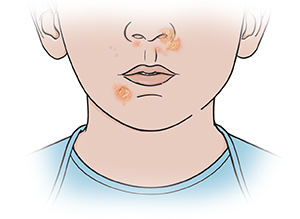When Your Child Has Impetigo
Impetigo is a skin infection caused by common bacteria. It often starts in a broken area of the skin. Impetigo looks like a rash with small, red bumps or blisters. The rash may also be itchy. The bumps or blisters often pop open, becoming open sores. The sores then crust or scab over. This can give them a yellow or gold look.
 |
| Impetigo on light skin. |
 |
| Impetigo on dark skin. |
How is impetigo diagnosed?
Impetigo is often diagnosed by how it looks. To get more information, the healthcare provider will ask about your child’s symptoms and health history. Your child will also be examined. If needed, fluid from the infected skin can be tested (cultured) for bacteria.
How is impetigo treated?
Impetigo generally goes away within 7 days with treatment. Antibiotic ointment is prescribed for mild cases. Before applying the ointment, scrub your hands first with clean, running water and soap. Scrub all areas of your hands, including between your fingers and under your fingernails. Then, gently clean the infected skin and apply the ointment. Wash your hands with the same process afterward.
Teach your child and all family members the correct way to wash their hands. Explain why correct handwashing is so important.
Ask the healthcare provider if there are any over-the-counter medicines to treat your child. In some cases, your child will take prescribed antibiotics by mouth. Your child should take all the medicine until it's gone, even if they start feeling better.
Call the healthcare provider if your child has any of the following:
-
Fever (See "Fever and children" below)
-
Symptoms that don't improve within 48 hours of starting treatment
-
Symptoms that get worse, or new symptoms
Fever and children
Use a digital thermometer to check your child’s temperature. Don’t use a mercury thermometer. There are different kinds and uses of digital thermometers. They include:
-
Rectal. For children younger than 3 years, a rectal temperature is the most accurate.
-
Forehead (temporal). This works for children age 3 months and older. If a child under 3 months old has signs of illness, this can be used for a first pass. The provider may want to confirm with a rectal temperature.
-
Ear (tympanic). Ear temperatures are accurate after 6 months of age, but not before.
-
Armpit (axillary). This is the least reliable but may be used for a first pass to check a child of any age with signs of illness. The provider may want to confirm with a rectal temperature.
-
Mouth (oral). Don’t use a thermometer in your child’s mouth until they are at least 4 years old.
Use the rectal thermometer with care. Follow the product maker’s directions for correct use. Insert it gently. Label it and make sure it’s not used in the mouth. It may pass on germs from the stool. If you don’t feel OK using a rectal thermometer, ask the healthcare provider what type to use instead. When you talk with any healthcare provider about your child’s fever, tell them which type you used.
Below are guidelines to know if your young child has a fever. Your child’s healthcare provider may give you different numbers for your child. Follow your provider’s specific instructions.
Fever readings for a baby under 3 months old:
-
First, ask your child’s healthcare provider how you should take the temperature.
-
Rectal or forehead: 100.4°F (38°C) or higher
-
Armpit: 99°F (37.2°C) or higher
Fever readings for a child age 3 months to 36 months (3 years):
-
Rectal, forehead, or ear: 102°F (38.9°C) or higher
-
Armpit: 101°F (38.3°C) or higher
Call the healthcare provider in these cases:
-
Repeated temperature of 104°F (40°C) or higher in a child of any age
-
Fever of 100.4° (38°C) or higher in baby younger than 3 months
-
Fever that lasts more than 24 hours in a child under age 2
-
Fever that lasts for 3 days in a child age 2 or older
How is impetigo prevented?
Follow these steps to keep your child from passing impetigo on to others:
-
Cut your child’s fingernails short to discourage scratching the infected skin.
-
Teach your child to correctly wash their hands with soap and clean, running water. Make sure they understand when they need to wash them. Handwashing is especially important before eating or handling food, after using the bathroom, and after touching the infected skin.
-
Teach your child not to touch their face.
-
Wash your child’s bed linens, towels, and clothing daily until the infection goes away.
-
Don't have family members share wash cloths or towels